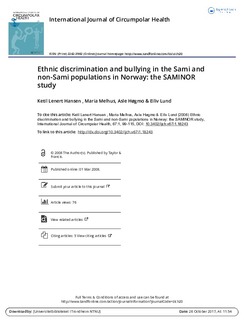| dc.contributor.author | Hansen, Ketil Lenert | |
| dc.contributor.author | Melhus, Marita | |
| dc.contributor.author | Høgmo, Asle | |
| dc.contributor.author | Lund, Eiliv | |
| dc.date.accessioned | 2017-06-07T12:36:49Z | |
| dc.date.available | 2017-06-07T12:36:49Z | |
| dc.date.issued | 2008 | |
| dc.identifier.citation | Hansen, K.L., Melhus, M., Høgmo, A. & Lund, E. (2008) Ethnic discrimination and bullying in the Sami and non-Sami populations in Norway: the SAMINOR study. International Journal of Circumpolar Health, 67(1). | |
| dc.identifier.uri | http://hdl.handle.net/11250/2444861 | |
| dc.description | Vitenskapelig artikkel basert på SAMINOR-studien. Omhandler etnisk diskriminering og mobbing i den samiske og ikke-samiske befolkningen i Norge. | |
| dc.description.abstract | OBJECTIVES: To investigate the prevalence of self-reported experiences of ethnic discrimination and bullying among Sami and non-Sami adults. STUDY DESIGN: Cross-sectional, questionnaire-based survey. METHODS: SAMINOR is a population-based study of health and living conditions that was administered in 2003-2004 in 24 different Norwegian and Sami populated municipalities within central and northern Norway. This analysis was based on 12,265 men and women aged 36-79 years. Ethnic distribution was Sami (33.1%), Kvens (7.8%) and the ethnic Norwegian majority (59.1%). RESULTS: Overall, Sami and Kven respondents reported more ethnic discrimination and bullying in general than ethnic Norwegians (p < 0.001). The reporting was highest among the younger participants (p < 0.001). Men reported more ethnic discrimination than women, while women reported more bullying. Respondents with the strongest Sami affiliation reported higher levels of ethnic discrimination outside the Sami Language Act`s district, while respondents with weak Sami affiliation, Kvens and ethnic Norwegians, reported higher levels inside this district. Among the respondents that reported bullying previously, the most common type was discriminating remarks and the most common location was public schools. For those who reported bullying in the past year, the most common types were gossiping and discriminating remarks, and the most common locations were at work and in the local community. Two out of three of those reporting ethnic discrimination, independent of ethnicity, also reported bullying. CONCLUSIONS: The findings from this study show that the Sami and Kven population more often experience bullying and ethnic discrimination than ethnic Norwegians. These results are consistent with experiences from other minority and marginalized groups that experienced colonization. More research is needed to understand the role bullying and ethnic discrimination play in the wellbeing and health of the Sami and Kven population. | |
| dc.language.iso | eng | |
| dc.rights | Navngivelse 4.0 Internasjonal | |
| dc.rights.uri | http://creativecommons.org/licenses/by/4.0/deed.no | |
| dc.subject | bullying | |
| dc.subject | ethnic discrimination | |
| dc.subject | indigenous | |
| dc.subject | kven | |
| dc.subject | minority | |
| dc.subject | sami | |
| dc.subject | mobbing | |
| dc.subject | etnisk diskriminering | |
| dc.subject | urfolk | |
| dc.subject | kvener | |
| dc.subject | minoritet | |
| dc.subject | samer | |
| dc.title | Ethnic discrimination and bullying in the Sami and non-Sami populations in Norway: the SAMINOR study | |
| dc.type | Journal article | |
| dc.type | Peer reviewed | |
| dc.rights.holder | Hansen, Ketil Lenert | |
| dc.source.volume | 67 | |
| dc.source.journal | International Journal of Circumpolar Health | |
| dc.source.issue | 1 | |
| dc.identifier.doi | 10.3402/ijch.v67i1.18243 | |

